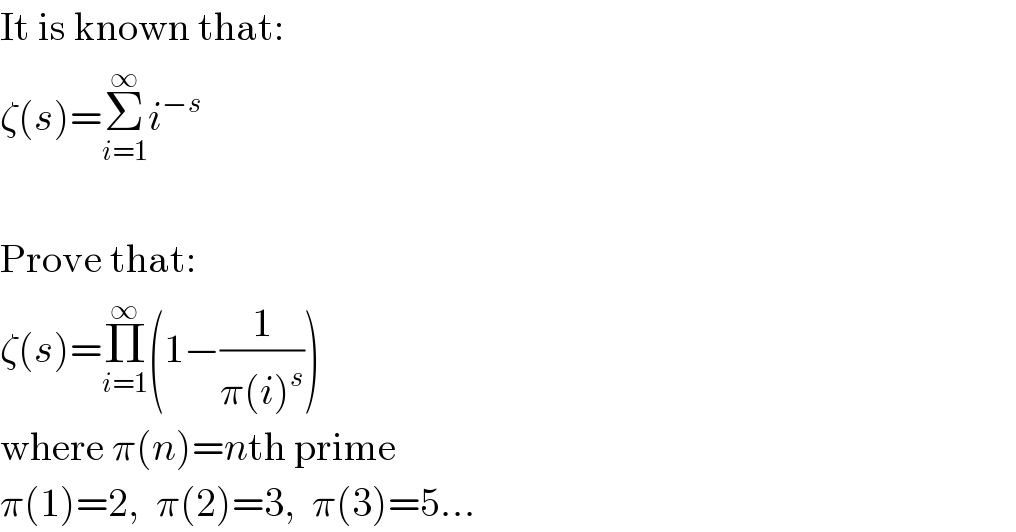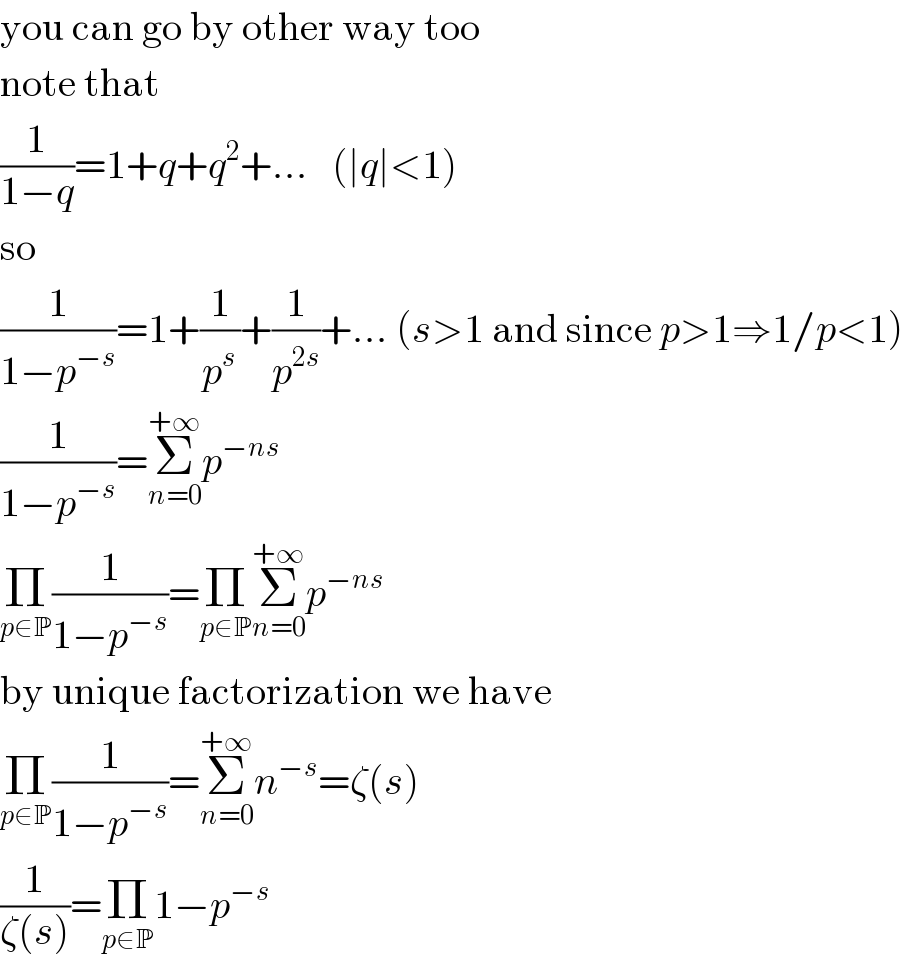
Question Number 3250 by Filup last updated on 08/Dec/15

$$\mathrm{It}\:\mathrm{is}\:\mathrm{known}\:\mathrm{that}: \\ $$$$\zeta\left({s}\right)=\underset{{i}=\mathrm{1}} {\overset{\infty} {\sum}}{i}^{−{s}} \\ $$$$ \\ $$$$\mathrm{Prove}\:\mathrm{that}: \\ $$$$\zeta\left({s}\right)=\underset{{i}=\mathrm{1}} {\overset{\infty} {\prod}}\left(\mathrm{1}−\frac{\mathrm{1}}{\pi\left({i}\right)^{{s}} }\right) \\ $$$$\mathrm{where}\:\pi\left({n}\right)={n}\mathrm{th}\:\mathrm{prime} \\ $$$$\pi\left(\mathrm{1}\right)=\mathrm{2},\:\:\pi\left(\mathrm{2}\right)=\mathrm{3},\:\:\pi\left(\mathrm{3}\right)=\mathrm{5}... \\ $$
Commented by 123456 last updated on 08/Dec/15

$$\underset{{n}\geqslant\mathrm{1}} {\sum}\frac{\mathrm{1}}{{n}^{{s}} }=\underset{{p}\in\mathbb{P}} {\prod}\frac{\mathrm{1}}{\mathrm{1}−{p}^{−{s}} } \\ $$$$\zeta\left({s}\right)=\underset{{p}\in\mathbb{P}} {\prod}\frac{\mathrm{1}}{\mathrm{1}−{p}^{−{s}} } \\ $$$$\frac{\mathrm{1}}{\zeta\left({s}\right)}=\underset{{p}\in\mathbb{P}} {\prod}\mathrm{1}−{p}^{−{s}} \\ $$
Answered by prakash jain last updated on 08/Dec/15

$$\zeta\left({s}\right)=\frac{\mathrm{1}}{\mathrm{1}^{{s}} }+\frac{\mathrm{1}}{\mathrm{2}^{{s}} }+\frac{\mathrm{1}}{\mathrm{3}^{{s}} }+\frac{\mathrm{1}}{\mathrm{4}^{{s}} }+.. \\ $$$$\frac{\mathrm{1}}{\mathrm{2}^{{s}} }\zeta\left({s}\right)=\frac{\mathrm{1}}{\mathrm{2}^{{s}} }+\frac{\mathrm{1}}{\mathrm{4}^{{s}} }+\frac{\mathrm{1}}{\mathrm{6}^{{s}} }+.. \\ $$$$\left(\mathrm{1}−\frac{\mathrm{1}}{\mathrm{2}^{{s}} }\right)\zeta\left({s}\right)=\mathrm{1}+\frac{\mathrm{1}}{\mathrm{3}^{{s}} }+\frac{\mathrm{1}}{\mathrm{5}^{{s}} }+...\:\left({all}\:{factors}\:{of}\:\frac{\mathrm{1}}{\mathrm{2}^{{s}} }\:{removed}\right) \\ $$$$\left(\mathrm{1}−\frac{\mathrm{1}}{\mathrm{3}^{{s}} }\right)\left(\mathrm{1}−\frac{\mathrm{1}}{\mathrm{2}^{{s}} }\right)\zeta\left({s}\right)=\mathrm{1}+\frac{\mathrm{1}}{\mathrm{5}^{{s}} }+...\:\left({all}\:{multiples}\:{of}\:\mathrm{3}^{{s}} \:{removed}\right) \\ $$$${repeating}\:{the}\:{process}\:{for}\:{all}\:{primes}\:{number} \\ $$$${each}\:{step}\:{remove}\:{multiples}\:{of}\:{a}\:{prime}\:{number} \\ $$$$\zeta\left({s}\right)\underset{{i}=\mathrm{1}} {\overset{\infty} {\prod}}\left(\mathrm{1}−\frac{\mathrm{1}}{\pi\left({i}\right)^{{s}} }\right)=\mathrm{1} \\ $$$$\frac{\mathrm{1}}{\zeta\left({s}\right)}=\underset{{i}=\mathrm{1}} {\overset{\infty} {\prod}}\left(\mathrm{1}−\frac{\mathrm{1}}{\pi\left({i}\right)^{{s}} }\right) \\ $$$$\frac{\mathrm{1}}{\zeta\left({s}\right)}=\underset{{i}=\mathrm{1}} {\overset{\infty} {\prod}}\left(\mathrm{1}−\pi\left({i}\right)^{−{s}} \right) \\ $$$$\mathrm{As}\:\mathrm{mentioned}\:\mathrm{in}\:\mathrm{the}\:\mathrm{question}\:\pi\left({i}\right)\:\mathrm{is}\:{i}\mathrm{th}\:\mathrm{prime}. \\ $$$$\mathrm{Usual}\:\mathrm{convention}\:\mathrm{is}\:\pi\:\mathrm{is}\:\mathrm{prime}\:\mathrm{density}. \\ $$
Commented by RasheedAhmad last updated on 08/Dec/15

$$\zeta\left({s}\right)=\frac{\mathrm{1}}{\mathrm{2}^{{s}} }+\frac{\mathrm{1}}{\mathrm{2}^{{s}} }+\frac{\mathrm{1}}{\mathrm{3}^{{s}} }+\frac{\mathrm{1}}{\mathrm{4}^{{s}} }+.. \\ $$$$\overset{?} {\Rightarrow}\frac{\mathrm{1}}{\mathrm{2}^{{s}} }\zeta\left({s}\right)=\frac{\mathrm{1}}{\mathrm{2}^{{s}} }+\frac{\mathrm{1}}{\mathrm{4}^{{s}} }+\frac{\mathrm{1}}{\mathrm{6}^{{s}} }+.. \\ $$
Commented by prakash jain last updated on 08/Dec/15

$${typo}.\:{corrected}. \\ $$
Commented by Filup last updated on 08/Dec/15

$${Amazing}! \\ $$
Commented by Filup last updated on 08/Dec/15

$$\mathrm{I}\:\mathrm{am}\:\mathrm{aware}\:\pi\left({i}\right)\:\mathrm{is}\:\mathrm{the}\:{prime}\:{density}. \\ $$$$\mathrm{But}\:\mathrm{I}\:\mathrm{have}\:\mathrm{seen}\:\pi\left({i}\right)\:\mathrm{be}\:\mathrm{used}\:\mathrm{on}\:\mathrm{several} \\ $$$$\mathrm{occasions}\:\mathrm{as}\:\mathrm{the}\:{n}\mathrm{th}\:\mathrm{prime}. \\ $$$$\mathrm{But}\:\mathrm{If}\:\mathrm{it}\:\mathrm{is}\:\mathrm{more}\:\mathrm{aesthetic},\:\mathrm{i}'\mathrm{ll}\:\mathrm{stick}\:\mathrm{to} \\ $$$$\left.{P}\left({i}\right)={i}\mathrm{th}\:\mathrm{prime}\::\right) \\ $$$$\mathrm{Thank}\:\mathrm{you}\:\mathrm{regardess}! \\ $$
Answered by 123456 last updated on 08/Dec/15

$$\mathrm{you}\:\mathrm{can}\:\mathrm{go}\:\mathrm{by}\:\mathrm{other}\:\mathrm{way}\:\mathrm{too} \\ $$$$\mathrm{note}\:\mathrm{that} \\ $$$$\frac{\mathrm{1}}{\mathrm{1}−{q}}=\mathrm{1}+{q}+{q}^{\mathrm{2}} +...\:\:\:\left(\mid{q}\mid<\mathrm{1}\right) \\ $$$$\mathrm{so} \\ $$$$\frac{\mathrm{1}}{\mathrm{1}−{p}^{−{s}} }=\mathrm{1}+\frac{\mathrm{1}}{{p}^{{s}} }+\frac{\mathrm{1}}{{p}^{\mathrm{2}{s}} }+...\:\left({s}>\mathrm{1}\:\mathrm{and}\:\mathrm{since}\:{p}>\mathrm{1}\Rightarrow\mathrm{1}/{p}<\mathrm{1}\right) \\ $$$$\frac{\mathrm{1}}{\mathrm{1}−{p}^{−{s}} }=\underset{{n}=\mathrm{0}} {\overset{+\infty} {\sum}}{p}^{−{ns}} \\ $$$$\underset{{p}\in\mathbb{P}} {\prod}\frac{\mathrm{1}}{\mathrm{1}−{p}^{−{s}} }=\underset{{p}\in\mathbb{P}} {\prod}\underset{{n}=\mathrm{0}} {\overset{+\infty} {\sum}}{p}^{−{ns}} \\ $$$$\mathrm{by}\:\mathrm{unique}\:\mathrm{factorization}\:\mathrm{we}\:\mathrm{have} \\ $$$$\underset{{p}\in\mathbb{P}} {\prod}\frac{\mathrm{1}}{\mathrm{1}−{p}^{−{s}} }=\underset{{n}=\mathrm{0}} {\overset{+\infty} {\sum}}{n}^{−{s}} =\zeta\left({s}\right) \\ $$$$\frac{\mathrm{1}}{\zeta\left({s}\right)}=\underset{{p}\in\mathbb{P}} {\prod}\mathrm{1}−{p}^{−{s}} \\ $$
Commented by Filup last updated on 08/Dec/15

$${Awesome}! \\ $$
Commented by prakash jain last updated on 20/May/17

$$\mathrm{123456},\:\mathrm{are}\:\mathrm{u}\:\mathrm{still}\:\mathrm{using}\:\mathrm{app}? \\ $$
